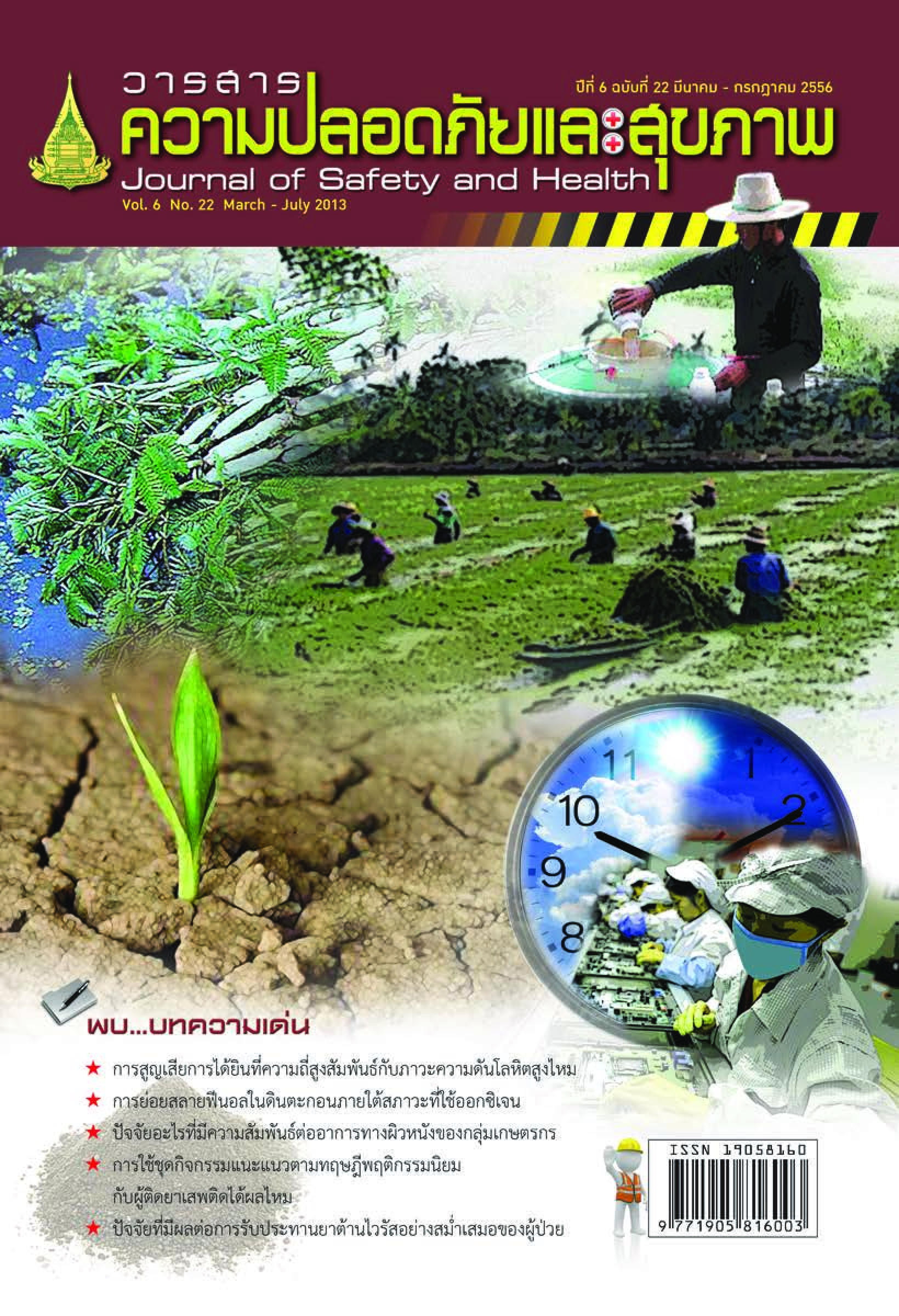การสูญเสียการได้ยินที่ความถี่สูงและภาวะความดันโลหิตสูงในพนักงานที่เข้ารับการตรวจสมรรถภาพการได้ยินที่ คลินิกอาชีวเวชศาสตร์ โรงพยาบาลนพรัตนราชธานี ในปี พ.ศ. 2554 - พ.ศ. 2555
Main Article Content
บทคัดย่อ
การศึกษานี้มีวัตถุประสงค์เพื่อหาความสัมพันธ์ ระหว่างการสูญเสียการได้ยินที่ความถี่สูงและภาวะความดัน โลหิตสูงในพนักงานที่เข้ารับการตรวจสมรรถภาพการได้ยิน ที่คลินิกอาชีวเวชศาสตร์ โรงพยาบาลนพรัตนราชธานี โดย ใช้รูปแบบการศึกษาเป็นแบบเชิงพรรณนา ณ จุดเวลาใดเวลาหนึ่ง
กลุ่มตัวอย่างประกอบด้วยพนักงานที่เข้ารับการตรวจ สมรรถภาพการได้ยิน ตั้งแต่ 1 ตุลาคม พ.ศ. 2554 – 30 กันยายน พ.ศ. 2555 จำนวน 1,147 คน มีพนักงานถูกตัด ออกจากการศึกษาจำนวน 374 คน เนื่องจากไม่มีผลการตรวจ วัดความดันโลหิต และมีการสูญเสียการได้ยินที่ความถี่ต่ำ คงเหลือกลุ่มศึกษาจำนวน 773 คน
ผลการศึกษาพบว่า ปัจจัยที่เกี่ยวข้องกับการสูญเสีย การได้ยินที่ความถี่สูงอย่างมีนัยสำคัญทางสถิติ (p < 0.05) ได้แก่ อายุ ประวัติโรคประจำตัวความดันโลหิตสูง การสูบบุหรี่ ระยะเวลาการทำงานที่ต้องสัมผัสเสียงดัง ความดัน โลหิตขณะหัวใจบีบตัวและความดันโลหิตขณะหัวใจคลาย ตัว เมื่อควบคุมปัจจัยด้านอายุพบว่า ความดันโลหิตขณะ หัวใจคลายตัวเป็นปัจจัยที่มีความสัมพันธ์กับการสูญเสีย การได้ยินที่ความถี่สูงของหูทั้ง 2 ข้าง ขณะที่ความดันโลหิต ขณะหัวใจบีบตัวมีความสัมพันธ์กับการสูญเสียการได้ยินของ หูซ้ายเพียงข้างเดียว โดยสรุป จากการศึกษาในครั้งนี้ พบว่า ภาวะความ ดันโลหิตสูงมีความสัมพันธ์กับการสูญเสียการได้ยินที่ความถี่ สูง หน่วยงานที่เกี่ยวข้องควรให้ความสำคัญและความสนใจ ในปัญหาดังกล่าวนี้เพื่อลดความเสี่ยงการเกิดโรคหัวใจและ หลอดเลือดต่อไป
Article Details

อนุญาตภายใต้เงื่อนไข Creative Commons Attribution-NonCommercial-NoDerivatives 4.0 International License.
Journal of Safety and Health is licensed under a Creative Commons Attribution-NonCommercial-NoDerivatives 4.0 International (CC BY-NC-ND 4.0) licence, unless otherwise stated.
เอกสารอ้างอิง
วิชิต ชีวเรืองโรจน์ (2544) การสูญเสียการได้ยิน. กรุงเทพมหานคร: โฮลิสติก พับลิชชิ่ง.
สมาคมความดันโลหิตสูงแห่งประเทศไทย (2012) แนวทาง การรักษาโรคความดันโลหิตสูงในเวชปฏิบัติทั่วไป พ.ศ. 2555. Retrieved October 8, 2013, from http:// www.thaihypertension.org/guideline.html
สุนันทา พลปัถพี และจรัส โชคสุวรรณกิจ (2554) ตำรา อาชีวเวชศาสตร์. กรุงเทพมหานคร: โรงพิมพ์ราชทัณฑ์.
เสาวรส อัศววิเชียรจินดา (2543) โรคหู. กรุงเทพมหานคร: โฮลิสติก พับลิชชิ่ง.
Andren, L., Hansson, L., Bjorkman, M., & Jonsson, A. (1980). Noise as a contributory factor in the development of elevated arterial pressure: A study of the mechanisms by which noise may raise blood pressure in man. Acta Med Scand, 207 (6), 493 – 498.
Chang, T.Y., Liu, C.S., Huang, K.H., Chen, R.Y., Lai, J.S., & Bao, B.Y. (2011). High-frequency hearing loss, occupational noise exposure and hypertension: A cross-sectional study in male workers. Environ Health, 10, 35.
Gan, W.Q., Davies, H.W., & Demers, P.A. (2011). Exposure to occupational noise and cardio vascular disease in the United States: The National Health and Nutrition Examination Survey 1999 – 2004. Occup Environ Med, 68 (3), 183 – 190.
Hirai, A., Takata, M., Mikawa, M., Yasumoto, K., Iida, H., Sasayama, S., & Kagamimori, S. (1991). Prolonged exposure to industrial noise causes hearing loss but not high blood pressure: A study of 2124 factory laborers in Japan. J Hypertens, 9 (11), 1069 – 1073.
Inoue, M., Laskar, M.S., & Harada, N. (2005). Cross-sectional study on occupational noise and hypertension in the workplace. Arch Environ Occup Health, 60 (2), 106 – 110.
Ising, H., & Kruppa, B. (2004). Health effects caused by noise: Evidence in the literature from the past 25 years. Noise Health, 6 (22), 5 – 13.
Koh, David. (2011). Auditory Disorders. In K.T. David Koh (Ed.), Textbook of Occupational Medicine Practice (3rd Edition). Singapore: World Scientifific Publishing Company.
Kristal-Boneh, E., Melamed, S., Harari, G., & Green, M.S. (1995). Acute and chronic effects of noise exposure on blood pressure and heart rate among industrial employees: The Cordis Study. Arch Environ Health, 50 (4), 298 – 304.
Mancia, G., Fagard, R., Narkiewicz, K., Redon, J., Zanchetti, A., Bohm, M., & Zannad, F. (2013). 2013 ESH/ESC Guidelines for the management of arterial hypertension: the Task Force for the management of arterial hypertension of the European Society of Hypertension (ESH) and of the European Society of Cardiology (ESC). J Hypertens, 31 (7), 1281 – 1357.
Narlawar, U.W., Surjuse, B.G., & Thakre, S.S. (2006). Hypertension and hearing impairment in workers of iron and steel industry. Indian J Physiol Pharmacol, 50 (1), 60 – 66.
Nelson, D.I., Nelson, R.Y., Concha-Barrientos, M., & Fingerhut, M. (2005). The global burden of occupational noise-induced hearing loss. Am J Ind Med, 48 (6), 446 – 458.
Passchier-Vermeer, W., & Passchier, W.F. (2000). Noise exposure and public health. Environ Health Perspect, 108 Suppl 1, 123 – 131.
Penney, P.J., & Earl, C.E. (2004). Occupational noise and effects on blood pressure: Exploring the relationship of hypertension and noise exposure in workers. AAOHN J, 52 (11), 476 – 480.
Pouryaghoub, G., Mehrdad, R., & Mohammadi, S. (2007). Interaction of smoking and occupational noise exposure on hearing loss: A cross
Spreng, M. (2000). Central nervous system activation by noise. Noise Health, 2 (7), 49 – 58. Wu, T.N., Shen, C.Y., Ko, K.N., Guu, C.F., Gau, H.J., Lai, J.S., & Chang, P.Y. (1996). Occupational lead exposure and blood pressure. Int J Epidemiol, 25 (4), 791 – 796.
Zhang, W.S., Zhou, H., Xiao, L.W., Wu, L., Wang, Z., He, G.Q., & Luo, X.L. (2012). A study on the relationship between hearing impairment and blood pressure and hypertension in workers occupationally exposed to noise. Zhonghua Lao Dong Wei Sheng Zhi Ye Bing Za Zhi, 30 (7), 517 – 520.


